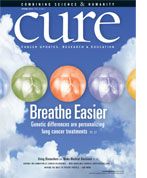Publication
Article
CURE
Exercise Improves Joint Pain Associated with Aromatase Inhibitors
Author(s):
Postmenopausal women whose breast cancer is fueled by hormones (estrogen receptor-positive breast cancer) are typically prescribed aromatase inhibitors (AIs), a class of drugs that includes anastrozole, letrozole and exemestane, for five years after surgery or primary treatment.
AIs stop the production of estrogen by blocking the enzyme aromatase, which converts the hormone androgen into estrogen. But AIs can sometimes cause harmful side effects, such as bone loss and rarely heart problems. The most common side effect, experienced by about half of women taking an AI, is arthralgia, a joint pain so persistent that it is reported to be the main reason women stop taking the drug.
At the 2013 San Antonio Breast Cancer Symposium, Melinda L. Irwin, co-leader of the Cancer Prevention and Control Research Program at the Yale Cancer Center, presented data from a randomized trial that investigated the impact of a yearlong exercise program on women who were taking AIs and experiencing joint pain.
The HOPE (Hormone and Physical Exercise) study examined 121 women who were physically inactive but able to exercise and who had been taking an AI for at least six months.
The participants, all of whom reported experiencing at least mild joint pain, were randomized to receive standard care (which included written information on the importance of exercise) or to participate in an exercise program that included twice-weekly supervised resistance and strength training sessions and at least 150 minutes per week of moderate-intensity aerobic exercise. Participants in the exercise group received free personal training and gym memberships.
After 12 months, the participants in the exercise group experienced a 20 to 30 percent decrease in joint pain, in addition to other benefits, such as weight loss and an increase in cardio-respiratory fitness. Participants receiving standard care reported a slight increase in pain.








